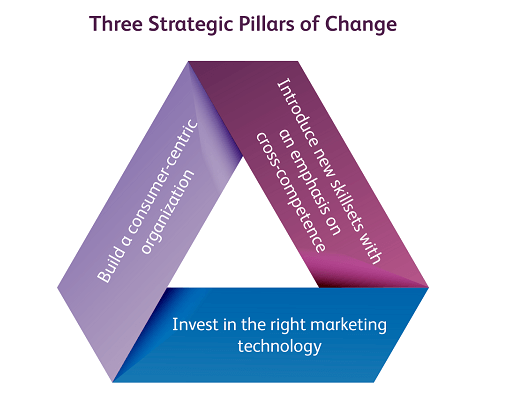When grappling with the new normal, countless food & beverage companies are looking for ways to build resilience for the future and remain relevant in a shifting landscape. However, with consumer needs changing at such a fast pace, food & beverage companies are finding that their key business processes will have to be re-engineered. With companies looking for ways to transform their processes, how do they even begin to start their digital marketing transformation?
The Current State of the Food & Beverage Industry
According to Clear Seas Research, the food & beverage beverage industry is focused on both their business goals and on the safety of families and employees. As organizations adjust to the rise of safety concerns and the current economy, there has been a steep decline in marketing budgets. As such, new business development activity has dropped by 66%. With organizations’ top areas of concerns centered around their ability to achieve their business goals, there is a much greater need for a way to connect with their consumers.
With 79% of organizations using email to communicate with their existing customer base, food and beverage leaders are looking at the messaging behind each conversation. Especially when using email to reach-out to new prospects and advertise their company, decision makers need a way to effectively capture information and use it to guide their actions and make decisions. However, how can organizations push their digital efforts to the next level?
Digital Marketing Transformation: Re-engineering Key Processes
When organizations start to envision their digital transformation journey, many become overwhelmed with the amount of tactical and strategic steps they will have to make; especially if they are new to the process. However, investing time and effort into planning a digital marketing journey will ensure its longevity. In our previous blog post, How to Build a Digital Marketing Journey that Lasts, we look at the importance of building a solid digital marketing foundation that organizations can continue to develop and invest in.
Various organizations that have relied on older methods of connecting with and understanding their customers, are finding it difficult to get a holistic understanding of what their customers need. In a time of great disruption and change, older organizations are starting to embrace their individual digital transformation journeys.
Digital Case Study: Thinking Big and Starting Small
A global food and beverage giant struggled with finding ways to keep up with a huge shift in consumer needs, while maintaining their brand as a trusted producer of foods. The client needed help with planning and implementing their digital marketing journey. In order to build a strong foundation for the client, we established three strategic pillars of change that were tailored to the client’s long-term goals and objectives.
Step 1: Building a consumer-centric organization—In order for the client to understand their consumer’s needs, they would need to create the optimum consumer experience as the first step. We looked at incorporating this into the consumer journey with the appropriate mix of channels, media, and personalized offerings.
Step 2: Introducing new skillsets—The client’s team needed to look at upskilling their UI/UX, content, innovation, analytics, and channels in order to reach their business goals and objectives. We also looked at finding ways to encourage a shift in the client’s mindset when it came to new ideas, self-education for new skillsets, and cross competence.
Step 3: Investing in the right marketing tech—Our team ensured that the right marketing platforms and technology stacks (Ad-Tech and Mar-Tech) would be incorporated to fit the client’s infrastructure and data requirements. By choosing technology that was best suited for the client, a frictionless marketing environment was created.
Through the establishment of these three pillars of change, the client was able to start enacting specific use cases which showed signs of change in a short amount of time. This allowed the client to build confidence in their digital marketing journey and continue to keep their eye on their long-term goals. Oftentimes, organizations hyper-focus on specific tactics that push their overall goals to the wayside. This can result in the impression that they are not finding success in their digital marketing journey.
The Next Generation of Digital Marketing
Whether it be the automotive or the food and beverage industry, digital marketing will be more than just a passing fad—it will be the future. Especially in times of change, having the right digital strategy will be the difference between growth and stagnancy. Every organization, regardless of industry or size, should consider itself to be a technology company who not only invests in digital infrastructure but also continues to learn and up-skill capabilities. Despite some organizations getting a head start in their journeys, now is the best time to start re-imagining key processes.
To learn how Digital Marketing 360 can help you get on the right foot of your digital marketing journey, please email analytics@evalueserve.com.




